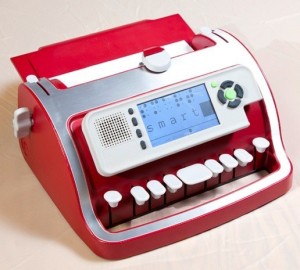The SMART Brailler is the long-awaited development of the Perkins Brailler from a low-technology classic to a high-technology learning and teaching device. Developed by Perkins Products and Product Development Technology (PDT) with support from the American Printing House for the Blind, the SMART Brailler opens the door to a new, more intuitive way for individuals, both sighted and blind, to communicate, teach and learn braille together. As a result, the technology bridges the gap among sighted teachers, classmates and parents of children who are visually impaired and enables them to work alongside students, ultimately providing a new level of learning support and making the inclusion of students who are blind into mainstream classrooms far more possible than ever before. Perkins Products Vice President & General Manager David Morgan says, “We are convinced that this truly levels the playing field and de-mystifies the braille ‘code’ to allow a shared learning experience for all – student, parent, teacher, friend. Adults who are losing their sight get a big screen and large text to learn braille independently.”

Features and benefits of the SMART Brailler include:
- A video screen that displays SimBraille and large print, combined with audio feedback, for an instantaneous, multi-sensory learning experience;
- The ability to edit, save and transfer electronic documents via USB;
- Built-in software with lessons for braille beginners (American Printing House version only; sold separately);
- Headphone jack and volume control;
- US English Braille, including contractions, and multiple language platforms including Spanish, French, German, Russian and Portuguese;
- Mechanical brailler capability;
- Rechargeable and removable battery.
The SMART Brailler’s video screen and audio feedback shows and speaks letters and words in real-time as they are being brailled in SimBraille or large print, for an instantaneous, multi-sensory learning experience. The USB port enables individuals who are visually impaired to create a hard copy document in braille and save it as a text file, which then allows an individual with sight to upload the document onto a computer and read it in print.
